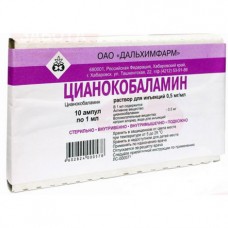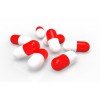Expiration date: 01/2025
Solution for injection
Composition
Active substance:
Cyanocobalamin - 0.2 mg or 0.5 mg
Auxiliary substances:
Sodium chloride — 9 mg, water for injection - up to 1 ml
Description of the dosage form
Transparent liquid from pink to red (for a dosage of 0.2 mg/ml) and from red to bright red (for a dosage of 0.5 mg/ml).
Pharmacodynamics
Vitamin B12. In the body (mainly in the liver) it is converted into methylcobalamin and 5-deoxyadenosylcobalamin. Methylcobalamin participates in the conversion of homocysteine to methionine and S-adenosylmethionine - the key metabolic reactions of pyrimidine and purine bases (and, consequently, DNA and RNA). If the vitamin is insufficient in this reaction, it can be replaced by methyltetrahydrofolic acid, while folic metabolic reactions are disrupted. 5-deoxyadenosylcobalamin serves as a cofactor in the isomerization of L-methylmalonyl-CoA in succinyl-CoA, an important reaction of carbohydrate and lipid metabolism. Vitamin B12 deficiency leads to a violation of the proliferation of rapidly dividing cells of hematopoietic tissue and epithelium, as well as to a violation of the formation of the myelin sheath of neurons.
Pharmacokinetics
In the blood, cyanocobalamin binds to transcobalamins I and II, which transport it to tissues. It is deposited mainly in the liver. The bond with plasma proteins is 90%. The maximum concentration after subcutaneous and intramuscular administration is reached after 1 h.
It is excreted from the liver with bile into the intestine and is reabsorbed into the blood. The half-life is 500 days. It is excreted with normal kidney function - 7-10% by the kidneys, about 50% by the intestines; with a decrease in kidney function - 0-7% by the kidneys, 70-100% by the intestines.
Penetrates through the placental barrier, into breast milk.
Indications
Conditions accompanied by vitamin B12 deficiency:
B12-deficiency anemia; as part of the complex therapy of anemia (including iron deficiency, posthemorrhagic, aplastic, anemia caused by toxic substances and / or drugs).
In complex therapy:
In neurology: neuralgia (including trigeminal neuralgia), polyneuropathy (including alcohol).
For preventive purposes — when prescribing biguanides, paraaminosalicylic acid, ascorbic acid in high doses, pathology of the stomach and intestines with impaired absorption of vitamin B12 (resection of part of the stomach, small intestine, Crohn's disease, celiac disease, malabsorption syndrome, sprue), radiation sickness.
Contraindications
Hypersensitivity to the components of the drug, thromboembolism, erythremia, erythrocytosis, pregnancy and breastfeeding.
With caution
Angina pectoris, benign and malignant neoplasms accompanied by megaloblastic anemia and vitamin B12 deficiency, a tendency to form blood clots.
Use during pregnancy and lactation
It is contraindicated to use the drug during pregnancy (there is evidence of the teratogenic effect of cyanocobalamin in high doses) and during breastfeeding.
Method of administration and dosage
Subcutaneously, intravenously, intramuscularly.
Subcutaneously, with B12-deficient anemia - 100-200 mcg / day every other day; with B12-deficient anemia with the addition of disorders of the nervous system - 400-500 mcg / day in the first week — daily, then with intervals between injections up to 5-7 days (folic acid is prescribed at the same time); during remission, the maintenance dose is 100 mcg / day 2 times a month, in the presence of neurological symptoms — 200-400 mcg 2-4 times a month.
In acute posthemorrhagic and iron deficiency anemia - 20-100 mcg 2-3 times a week; in aplastic anemia, anemia caused by toxic substances and / or drugs — 100 mcg before the onset of clinical and hematological improvement. For disorders of the nervous system — 200-400 mcg 2-4 times a month.
In neurology: neuralgia (including trigeminal neuralgia), polyneuropathy (including alcohol) - 200-500 mcg every other day for 2 weeks.
For preventive purposes - 50-100 mcg daily for 20-30 days.
To eliminate vitamin B12 deficiency, it is administered intramuscularly or intravenously, 1 mg daily for 1-2 weeks.
For young children with alimentary anemia and premature infants - subcutaneously, 30 mcg per day daily for 15 days.
Side effects
Allergic reactions, mental agitation, cardialgia, tachycardia, diarrhea, headache, dizziness, hypercoagulation, violation of purine metabolism.
Overdose
No data available.
Interaction
Pharmacologically incompatible with ascorbic acid, heavy metal salts (cyanocobalamin inactivation), thiamine, pyridoxine, riboflavin (because the cobalt ion contained in the cyanocobalamin molecule destroys other vitamins).
The risk of allergic reactions increases when combined with thiamine.
Aminoglycosides, salicylates, antiepileptic drugs, colchicine, potassium preparations reduce the absorption of cobalamin.
Chloramphenicol reduces the hematopoietic response of cyanocobalamin.
It should not be combined with drugs that increase blood clotting.
Special instructions
Vitamin B12 deficiency should be confirmed diagnostically before prescribing the drug, since it can mask a lack of folic acid. During the treatment period, it is necessary to monitor peripheral blood parameters: on the 5-8 day of treatment, the content of reticulocytes and the concentration of iron are determined. The number of red blood cells, hemoglobin and color index should be monitored for 1 month 1-2 times a week, and then 2-4 times a month. Remission is achieved when the number of red blood cells increases to 4-4.5 million / ml, when the normal size of red blood cells is reached, aniso- and poikilocytosis disappears, and the number of reticulocytes normalizes after a reticulocyte crisis. After achieving hematological remission, peripheral blood monitoring is carried out at least once every 4-6 months.
Be careful in people prone to thrombosis, with angina pectoris (in smaller doses up to 100 mcg per injection).
The effect of the drug on the ability to drive vehicles, mechanisms
The effect of the drug on the ability to drive vehicles and engage in other activities that require concentration and speed of psychomotor reactions has not been reported. However, given that the drug can cause dizziness, caution should be exercised when carrying out these types of activities.
Release form
Solution for injection 0.2 mg / ml, 0.5 mg / ml.
1 ml in ampoules of neutral glass.
10 ampoules together with the instructions for use are placed in a cardboard box.
5 ampoules are placed in a contour cell package.
2 contour cell packages together with the instructions for use are placed in a pack of cardboard.
Storage conditions
In a place protected from light at a temperature not exceeding 25 ° C.
Keep out of reach of children.
Expiration date
2 years.
Do not use after the expiration date




